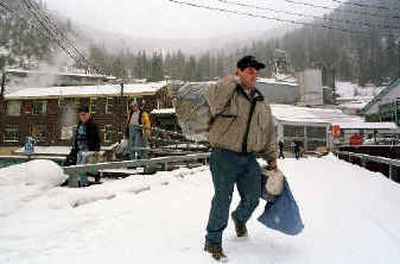Mining decline leads to fewer engineers

As decade-high gold and silver prices spark a renewed interest in mining in the West, there are few mining education programs and fewer students earning mining engineering degrees due to two decades of decline in the U.S. mining industry.
This academic year, about 100 students will graduate with mining engineering degrees, according to the Society for Mining, Metallurgy and Exploration. That compares to nearly 700 similar degrees granted nationally in the 1980-81 academic year, during a mining boom.
“What we have experienced is a decline in enrollment at mining engineering and geology engineering programs,” said Sharon Schwartz of the Littleton, Colo., organization. “The society has been working with educators on ways to stop the decline and increase enrollment.”
Mining engineers are needed to help construct the tunnels, shafts and drifts of underground mines, as well as to oversee the complex chemical processes used to separate gold from ores.
Today, 15 schools offer undergraduate mining engineering degrees in the United States, down from 25 in the early 1980s, according to the SME.
Less mining activity in the United States has led to cuts in mining engineering programs, said Tibor G. Rozgonyi of the Colorado School of Mines at Golden, Colo.
Employment in the field is projected to decline through 2012, the bureau predicts.
Despite the projected decline, the small occupation holds good job prospects over the next decade as a significant number of current mining engineers approach retirement age, experts said.
The need for mining engineers has increased as gold recently sold for a 16-year high of more than $450 an ounce and silver traded for a decade-high of just under $8 an ounce.
Environmental engineering graduates can look forward to more available jobs, because the field is becoming an engineering specialty, according to the U.S. Labor Department.
At Montana Tech in Butte, students in the School of Mines get courses both in how to build an environmentally sound mine and to clean up afterward, admissions director Ray Rogers said.
“We incorporate a fair amount of course work in environmental management into our curriculum,” he said. “At the same time, we’re still teaching how to permit and operate a mine and how to do it in an environmentally safe manner.”
The mining school has placed nearly all of its graduates over the past decade in mining jobs, yet still hasn’t kept up with demand, he said.
“We have companies calling all the time for mining engineers,” Rogers said. “We have to tell them ‘no.’ We don’t have enough graduates to supply their needs.”
Despite starting salaries averaging about $50,000 a year, mining schools are having trouble attracting students to traditional mine engineering courses, Rogers said.
“Students today are very much influenced by the sexy programs, such as biological engineering and aeronautical engineering,” he said. “Programs like mining engineering don’t get nearly the press.”
Professor Tuncel Yegulalp is the last mining engineering professor at the Henry Krumb School of Mines at Columbia University in New York.
“I do teach courses related to mining, but from an environmental angle,” Yegulalp said. “Columbia still has a school of mines by name. But we’re looking at the entire planet Earth. There are some remnants of mining tradition hanging in there, but we have no mining students per se.”
Montana Tech’s Rogers said there are still tremendous opportunities in mining, despite the past downturns.
“But it’s a tough sell. Mining is a really difficult career to get students to think about,” Rogers said.
Not everyone in the industry sees a potential dearth of mining engineers.
Earl Bennett is a mining consultant and former dean of the Idaho School of Mines, which closed in 2001 after only one engineering student graduated.
There are enough mining schools left to produce the 200 or so engineers the industry needs each year, Bennett said.
“There’s not going to be a hue and cry for hundreds of mining engineers,” he said. “It’s a fairly small profession. If the demand gets bigger, you will see a comeback.”